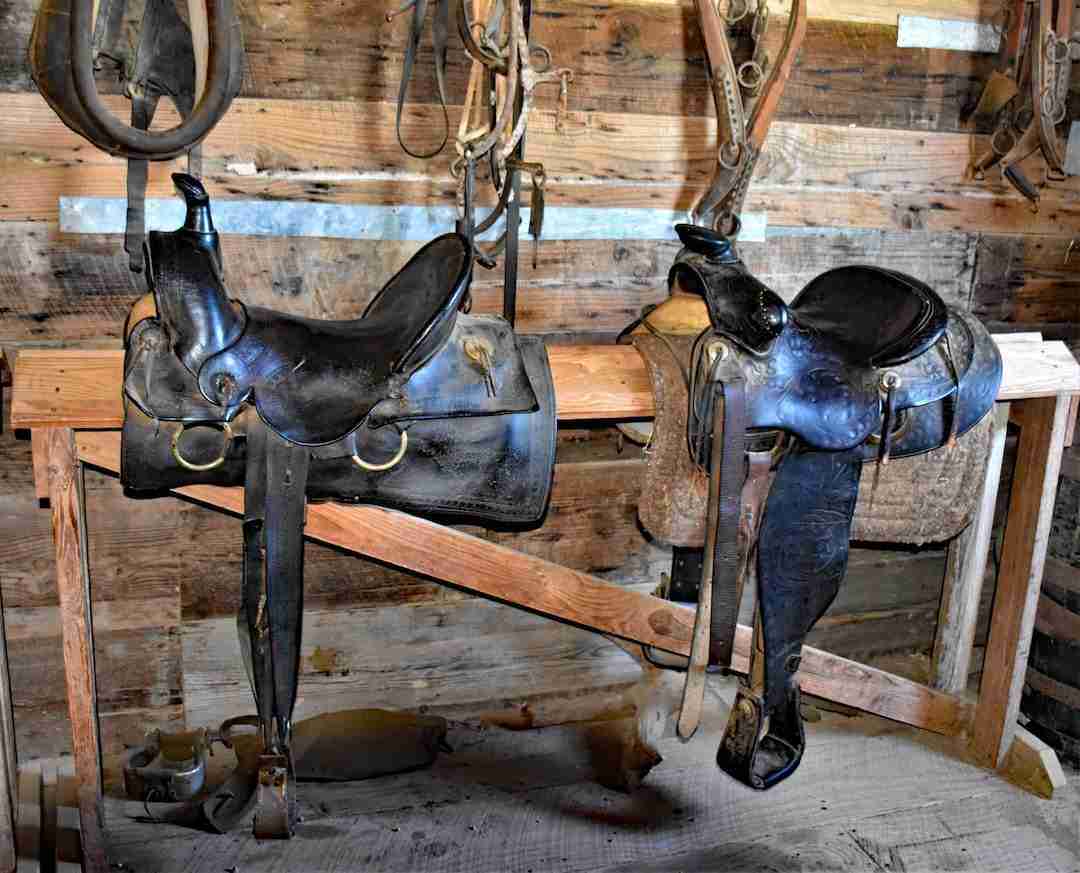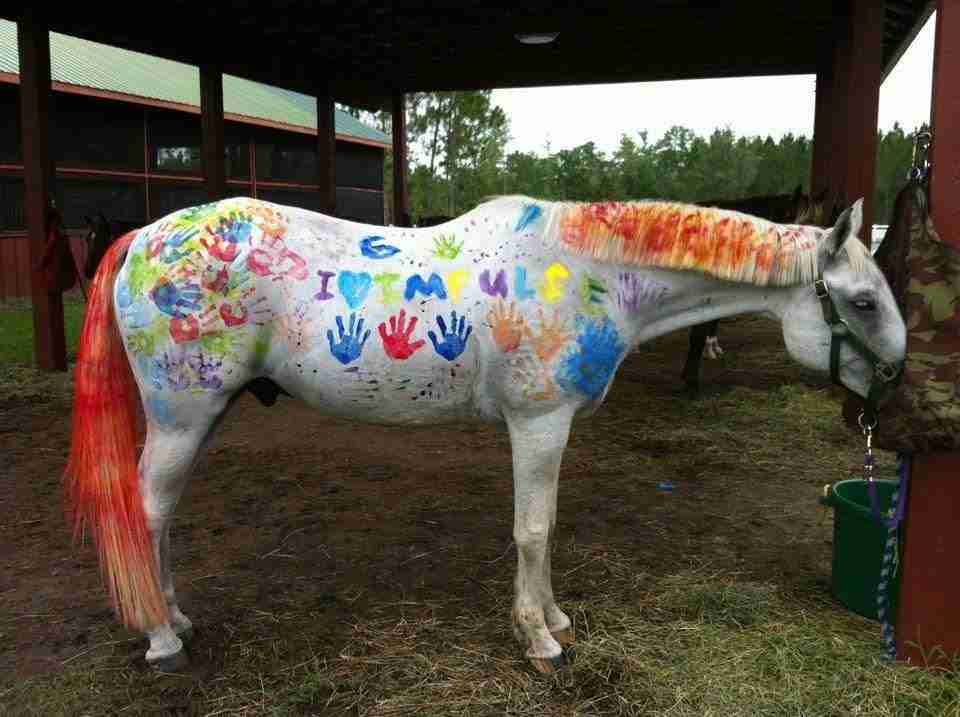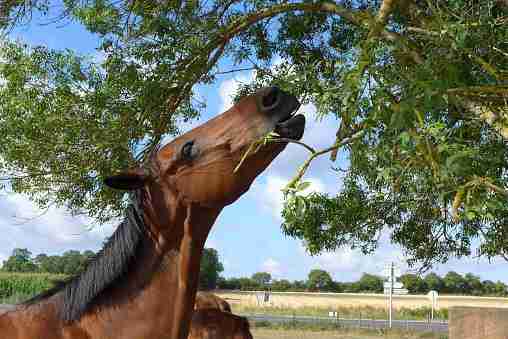We love to communicate with our horses, and often wonder why do horses nod their heads; we are sure they understand and sometimes respond to what we say. However, we have the luxury of speech; unfortunately, horses don’t. Therefore, they use many different gestures to communicate or react to situations, either physically or emotionally. The nodding of their heads is one example of such an expression.
Horse nodding can depict either happiness or distress. Horses mainly express joy by nodding their heads when excited or having excess energy. However, frantic nodding can be a sign of irritation, and additionally, a nodding horse in trot can indicate either front or rear lameness.
During the many years I taught riding lessons, students would ask me why the horses shake and nod their heads. Well, I usually gave some one off answer, but it always made me ponder that question for a more scientifically correct answer. Although I grew up with horses, I had to do some research and found a few interesting facts. So, why do horses nod their heads, and is it the same as shaking?
Is It Normal For Horses To Nod Their Heads?
The horse’s neck is part of its motion system with integrated muscles. For example, when the shoulder muscles pull up and forward, it pulls the neck down. Then, when the leg hits the ground, the neck muscles release, and the neck moves up. Therefore, neck ligaments store and release energy with the nodding of the head.
If only horses could talk, it would make our lives much more accessible and happier. Nevertheless, to start delving into the question and getting relevant answers, we must firstly look at the different horse motions and each related to the horse’s head movement, and secondly, determine if there aren’t other, more classical explanations for nodding horses.
Why Do Horses Nod Their Heads?
Well, many will argue that horses will bob their heads while in motion and sometimes nod as a sign of communication, either by showing affection or notifying you of some distress. Regardless, both express the normal vertical movement of the head and, in some instances, showcase an indicator of possible abnormality.
Nodding Horses While Grazing In The Field
The interaction of the neck and shoulder muscles depicts normal vertical head movement in horses while in motion. Understandably, horses should not abnormally nod while grazing or being idle in the field. It may signify too much energy, excitement, or irritation if they do. In addition, slow nods should also not be alarming as there are many reasons for typical head up-and-down movements.
Nodding Horses While Walking

With the neck and shoulder muscle interactions, horses will move their head up and down while walking. Some horse breeds have over-accentuated head nods while walking as part of their posture and physique. In addition, while walking, each horse’s feet move individually with the head in rhythm. This movement is the same motion a horse rider expresses to stay with the horse’s rhythm.
Nodding Horses While Cantering

Typically, there will be some head bobbing movement while the horse canters. Canter is when the horse moves ahead with small strides putting one hoof down and then the diagonal opposite hoof pair, and after that, the remaining hoof. Therefore, these small leaping strides cause head movement due to muscle and balance actions.
Nodding Horses While Galloping

While the horse is at a gallop, there will also be head movement as the horse’s whole body moves as one entity. Typically, the horse gallop is a three-beat motion or a faster four-beat gallop. The horse’s head bobs up and down in the gallop when all four hoofs hit the ground directly one after each other. The forward motion with the neck and shoulder muscles causes the nodding effect.
Nodding Horses While Trotting

Let us assume all horses express head bobbing while in motion; however, surprisingly, they don’t bob or nod their heads at a jog. Instead, trotting is a typical two-beat gait when the horse uses its diagonally opposite pairs of hooves to gain motion in sequence between hoof pairs. Notably, this gesture is gracious and predominantly without head bobbing—horses limp by using their heads.
The rule is that a jog does not have the horse’s head bobbing up and down unless there is something wrong with its leg or foot. Therefore, when a horse has a noticeable nod of the head while trotting, it should get tested for lameness. It may be that the horse is in pain on their front. In addition, the trot is the best way to determine if a horse has lameness quickly. Now, watch this video on Beautiful Horse Trotting
13 Reasons To Explain Why Horses Nod Their Heads
When people walk or run, we use our arms to swing them for balance; they connect to our legs through various ligaments and muscles. Similarly, horses use their heads, and noticing their normal or abnormal head movements can tell us much about what they are experiencing or want to say. We listed thirteen of the typical and common horse nodding reasons below.
1. They have ear infections or insects in their ears
Horses will nod if something in their ears is bothering them. For example, they will shake with sharp, quick nodding movements, which may also coincide with side movements of the head.
2. They are showing submission or greeting
It is as if horses know the differences in nodding. If they nod their heads calmly and in a controlled manner, they are showing you that they are submissive and are at your mercy. Also, they may say hello, as humans do, by nodding their heads.
3. Observe objects that are far away
Because of the positioning of their eyes, they will also lower their heads to focus on things that are far away. This focus may then appear as nodding. However, this movement is typically a very slow nod or two.
4. They don’t like the bits in their mouth
It is possible that the bits are uncomfortable and nodding continuously to alleviate or adjust the bits. Typically, the nodding will coincide with lip movements as well.
5. They are ready to go
Too much energy is one of the known symptoms of head nodding horses. They may be telling you they are prepared to go. On the other hand, the nodding may be out of frustration because the rider has a firm hold on the reins, and they are ready. Horses on a loose rein seldom nod as they can take off freely.
6. They are playing
Similarly, horses may appear restless and noddingly express their excitement with all their energy. However, always look carefully because it is easy to confuse excitement with irritation.
7. The sunlight is bothering them
Some horses are more sensitive than others to sunlight. A nerve in their head will react to the bright sunlight and cause a sensation. The sensation will result in the horse moving its head up and down. Notably, this nodding is more of a quick reaction and is typical behavior in the summer.
8. Problem with its teeth
When horses nod while eating or grazing, their teeth may be problematic. One remedy is to have their teeth floated. In addition, they can also develop a tooth abscess. A nasty odor will be prominent, and the diagnosis would then confirm an abscess. However, nodding while eating can also be happiness.
9. They are enjoying their meal
Some horses head-nod while eating, which may relate to excitement. In addition, it may result from moving the food around in the mouth while chewing. In some cases, when introducing new food or treats, the horse may nod while eating. However, it should stop after a few days or once they are used to the change.
10. They are agitated or frustrated
In contrast to excitement and energy when ready to go, horses can also be frustrated and restless because of irritations. For example, when being groomed or you are busy tacking up for a ride. Check the brushes and restart the saddle fit, ensuring there is nothing that can cause excessive nodding.
11. Lameness
Horses with signs of lameness will also nod or head bump as they will show their hind limb discomfort by first dropping their head and then raining it. Lameness is also noticeable when they trot less spectacularly than before and head bobbing. A horse’s head should be steady without nods at a trot.
12. Get your attention
Sometimes when we are not facing horses directly, they will try and get our attention in a few ways. One such example is tapping us with a head nod. Horse nodding does not always mean there is a problem. They are communicating in the only way they can and know how.
13. Happy to see another horse
When a horse is happy to see another, it may also nod in excitement. This gesture is similar to foals, for example, where they shake their heads franticly up and down, seeing the mother. Similarly, stallions show nodding excitement when they approach a mare.

What To Do When You Have A Nodding Horse
Firstly, nodding or bobbing is predominantly normal horse behavior. However, the critical factor is excessive, and you will probably know best when your horse bobs more than usual. Secondly, never punish a horse for head nodding as it is the only way they can express and show their opinion. So, if you punish him, it will tell them you do not care about their opinion, which may worsen the problem.
In addition, a headbutt from your horse may be a nodding accident. Indeed, if horses could, they would say, “Sorry, Bud, I was just trying to get your attention.” However, horses can have displaced behavior, and it is always a good idea to consult a vet or experts if you are unsure.
In addition, check the hoofs, saddle, and brushes when they show agitation in those areas. Sometimes the saddle fit or placement can be uncomfortable, and ensure the saddle girth doesn’t irritate them. Lastly, give attention and talk to them to keep them calm. They need attention and want to please you while relieving their excessive energy.
Other Articles To Read:
Is Horse Nodding And Headshaking The Same?
No, nodding and shaking, for the most part, are not the same, and there are different reasons for horses nodding, bobbing, or shaking their heads. However, there are certain parallels, such as that head tossing or shaking can be caused by insects, an uncomfortable saddle, or dental problems. Therefore, head shakings are mostly a display of negativity, and nodding, with exceptions, is a more positive gesture.
Headshaking can be a disease classified as one of the common stereotypies such as cribbing, windsucking, and weaving. These behaviors are stall vices and typically affect about 15% of domesticated horses. Therefore, horse headshaking is a behavior that may be the result of the overactivity of specific nerves that supply face sensations.
How To Recognize Head Nodding As Lameness In My Horse
Head nodding or bobbing while on a trot is the best way to identify possible lameness in a horse. It is not a diagnosis you want to make, but a necessary one to catch early and prevent the horse from pain and uncomfortable situations.
Front and hind lameness will mainly present when the horse lifts its head from the level position to limit the weight on the problem leg. When a trotting horse holds its head upward, it may have lameness at the back or rear hoof issues. In contrast, when the horse’s head is bobbing, it may indicate lameness in the front part of the horse.
Frontal lameness is more common, but both show possible laminitis, hoof issues, or something stuck in the hoof. It is always worth checking what the reason is. Therefore, although all horses bob when walking, cantering, or galloping, they should keep a still head when in trot. Also, a horse with lameness nods more than average when distributing the weight between the healthy and lame leg or foot.
When horses are in pain or suffering from some irritation, they utilize their heads through nodding to communicate. They will transfer the weight from their affected legs to their head through the shoulders to alleviate the weight and pain. Therefore, the horse’s torso will move down when the healthy leg touches the ground and then up again when the sore leg carries the weight.
Exercise your horses on a stable surface to treat and prevent navicular disease. Although eating choices have no bearing on lameness, conditioning and maintaining a healthy weight can. This reduces stress on the tendons, hooves, and legs. Check out this video: How Do You Know If Your Horse Is Head Nodding?
Seasonal Headshaking
Some studies show higher head shaking instances in geldings, nearly twice as often as mares. John Madigan, DVM, MS, Dipl. ACVIM, a professor of veterinary medicine at the University of California, Davis, is recognized as the leading expert on equine headshaking syndrome. Years of examining difficult cases have led him to question why this phenomenon is seasonal– as many as two-thirds of headshaking cases occur in spring.
Madigan says there is a rise in reproductive hormones called gonadotropins in the spring, and this is normally associated with the breeding season typical of horses. He explains,
“This surge occurs as days lengthen. Geldings have no testosterone feedback, so they have higher levels of gonadotropins, like FSH (follicle-stimulating hormone) and LH (luteinizing hormone), for a period of time.”
How do gonadotropins influence the trigeminal nerve? Madigan explains, “The hormones seem to affect some part of the trigeminal ganglia, altering its chemistry and rendering it unstable. (Ganglia provide relay points and connections between nerves.) As normal sensory ‘traffic’ comes into the trigeminal ganglia, then additional triggers like light, sound, smell, or exercise may stimulate this nerve to ‘fire.’
“The horse then receives neuropathic pain such as burning, itching, tingling, or electriclike sensations, any of which are manifestations of horses with headshaking,” he adds.
Madigan explains how exercise might trigger headshaking behavior: “The autonomic activity of exercise initiates a lot of activity in the nasal area, such as engorgement of the nasal turbinates and snorting that is normal to clear the nostrils so the horse doesn’t inhale dust or debris. Higher speeds and more effort ramp up stimulation within the head, each stimuli increasing ‘traffic’ in the trigeminal area.”
Madigan notes two other primary risk factors for headshaking:
A horse that has gained weight, as, for example, during a layoff; A horse that does not regularly perform aerobic exercise.
Madigan proposes a therapeutic protocol that he has found successful in treating headshaking:
Measure gonadotropins (LH) and lower their levels by administering daily melatonin (12-16 mg) at 5 p.m. This “tells” the horse’s body that it is winter. He reports good results for seasonal headshakers.
Feed the label dose (4 ounces) of magnesium oxide (Quiessence) to raise the threshold for “firing” of the trigeminal nerve.
Feed the label dose of spirulina (a homeopathic product) to raise the threshold of for firing of the trigeminal nerve.
Madigan stresses that it may take four to eight weeks until results are appreciated with this combination of therapies. There are a multitude of factors involved, you should always try and determine the circumstances, explain problem to your vet and have to go through a process of elimination to help the horse.
Level 1
Expression calm and relaxed in all activities..
Level 2
Rubs nose on stall or other objects, sneezes or coughs, stamping, dislikes grooming, may shake head vertically. May be spooky and distracted. May rub nose on legs, even while moving forward.
Level 3
Stares, disconnected from the environment and focused on self, ears twitching, tightens chin, flips nose downward, horizontally or otherwise shakes head 0-2 times in 15 minutes.
Level 4
Sneezes, coughs, slightly agitated, flips nose downward in sudden, extreme movements (approximately 1-5 times in 15 minutes), rubs nose on legs or any other object nearby. May become light sensitive at this point.
Level 5
Entire neck may become involved with up and down vertical and repetitive movements, the horse becomes more agitated, headshaking increases to 5-15 times in 15 minutes. May strike with legs at nose, becomes panicky and either won’t move forward or wants to run.
Level 6
More continuous headshaking at 15-30 times a minute. May become extremely panicked and frantic to the point of hurting himself or others around him, headshaking 30 – too numerous to count.
Conclusion
So, why do horses nod their heads? Horses typically nod or bob for a reason. – It can be a happy or a distressful reason. Either way, slower nods are usually excited and affectionate, while faster and frantic nods may indicate distress or irritation. Always pay attention to horse head nodding as they try to tell you something such as “Hi, I am happy to see you,” or “Help, I am in pain.”
Resources









